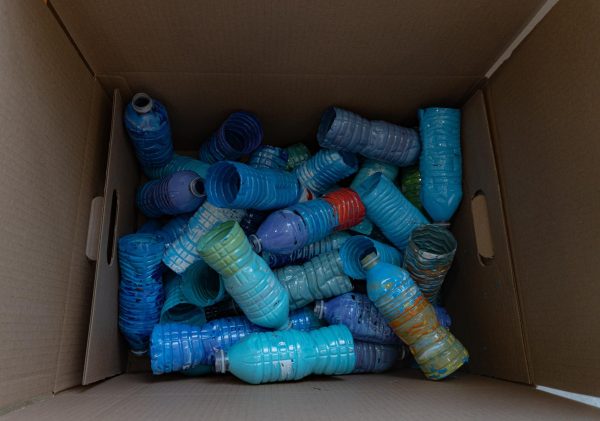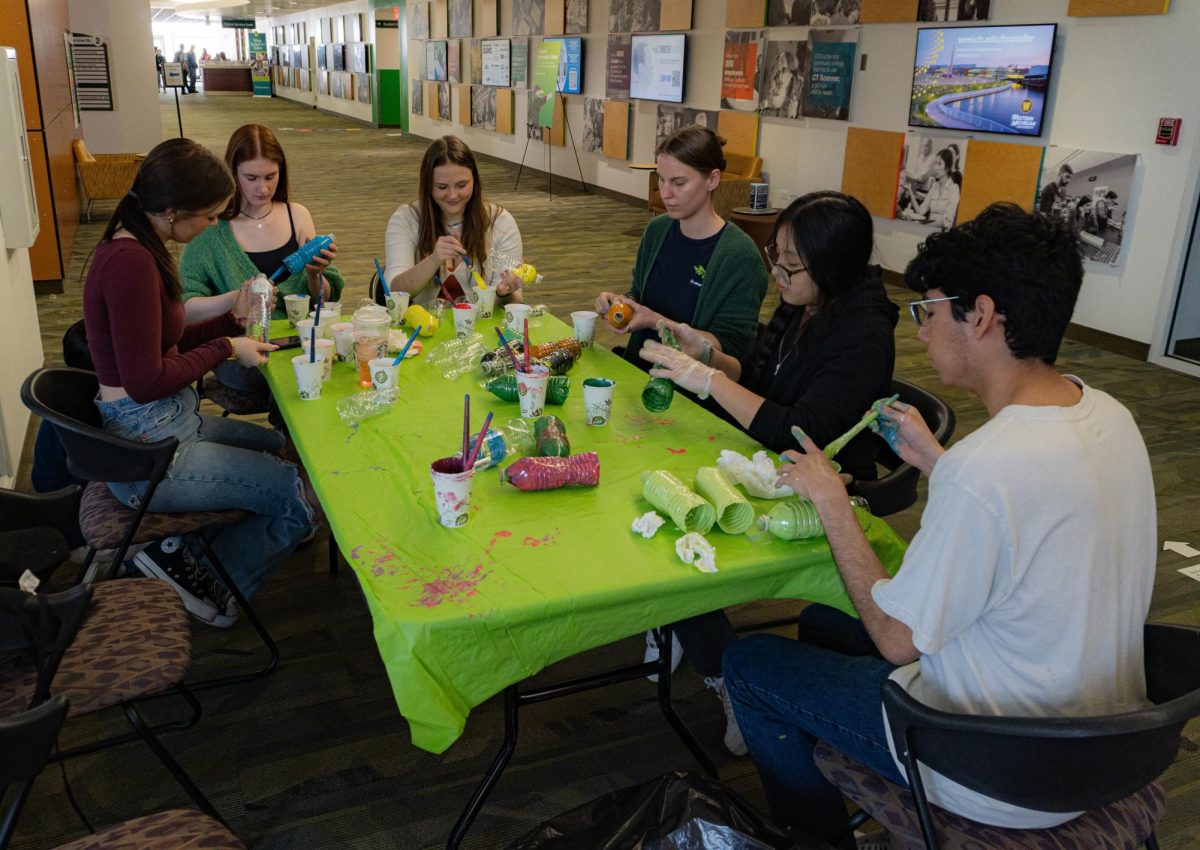Approximately 79% of all plastic that has ever been made remains in landfills to this day. Plastic water bottles, a major pollutant, are constantly found strewn in natural habitats and dumped in the ocean, disrupting our environment. COD Cares, College of DuPage’s volunteer corps, aims to alleviate that issue through a three-phase collaborative upcycling art project open for all to participate in.
This past Wednesday, College of DuPage students passing by the Wings Art Gallery in the SSC were invited to stop by and paint over one thousand discarded water bottles collected from students, faculty and staff by COD Cares in various colors using acrylic paint, as part of a larger art project that has yet to be unraveled in the coming weeks. It is part of COD Cares’ annual spring campaign entitled “Roll Up Your Sleeves,” which aims to promote environmental responsibility and conservation through volunteer work.
Joan Di Piero, a community engagement coordinator and manager of COD Cares, said COD Cares had contributed to eco-friendly activities before and continues to educate and inspire volunteers.
“Each year we do two big projects,” she explained. “One in the fall, one in the spring. April is Earth Month; so we’ve also always done something that is focused on the environment. We’ve done gardening. We’ve done exterior painting for places. We learned how to compost last year, which was lots of fun.”
Di Piero explained that the painted water bottles will be altered into spiral shapes and arranged together to eventually form large, glass-like chandelier structures inspired by the works of glass artist Dale Chihuly, who is known for his colorful, intricate glass art sculptures that are sometimes suspended from ceilings.
“We’re painting the interior of the water bottles this week,” Di Piero said. “Next week, we’re going to cut the dried water bottles into spirals. The following week— the last week— we’re going to adhere them to a heavy-duty cardboard post and make Chihuly-inspired art. One will be here in the Wings Gallery. We’re going to give one to Scarce, which is our environmental partner in our community. And if we have one more, I’d like to put something up near the greenhouse on campus.”

According to Beyond Plastics, less than 9% of the 51 million tons of plastic used by Americans per year end up being recycled. Littered plastics break down into toxic particles that contaminate water and soil, posing harm to the health of both humans and animals.
Zoe LaFaire, a student at College of DuPage, painted water bottles for the project after receiving an email about the project. She feels deeply about environmental matters, which motivated her to contribute.
“I’m really passionate about environmental activism,” she said. “I think repurposing what would be considered trash is beautiful and making it worth something more than just garbage.
“We only have one world,” she added. “I know they’re thinking of how to make hotels in space or whatever, but this is Mother Earth, and she’s been good to us. We should probably be good back.”
Kasper Zabawa, a student at COD, stopped by to paint several water bottles for the project as a way of destressing.
“I was a little stressed, and then I was invited to paint the bottles,” he said. “I felt like that would help me calm down, and it did.”
Di Piero hopes to spread awareness of how much plastic water bottles pollute the environment. She discourages people from using them, suggesting reusable water bottles instead.
“I would like students to understand that it’s important to repurpose,” she said. “If you’re using this kind of water bottle, make sure that you either recycle it, repurpose it into art, or refuse it at the store to begin with. Just say, ‘No, I’ll take glass or something else, because this is the kind of stuff that ends up in the ocean and doesn’t make it to the landfill.’”
Zabawa believes the art project has the potential to encourage sustainable efforts among COD students. He added that there are many labeled waste bins on campus that encourage people to properly sort out and dispose of their unwanted material.
“I think I could definitely see this inspiring a couple of people walking by,” he said. “I notice a lot of recycling bins, and they say whether to put bottles, cans or paper. So I think if students pay attention for that, it would go a long way [to help the environment].”
LaFaire emphasized the importance of encouraging collaborative environmental efforts among the general public, particularly students.
“I think projects like these that get the student body involved are definitely very beneficial,” she professed. “Get the students and the faculty involved in governance and activities that can help the environment.”
Heidi Metcalf, an interior design professor at College of DuPage who teaches a class in Sustainable Design, took her students from one of her classes to the art project. Having facilitated interior design projects in her class involving recycled material, she explained how COD exposes students to different methods and ways of contributing to a healthier environment. These finalized projects can be found right on COD’s campus.
“In our program, we have a class called Sustainable Design,” she explained. “Essentially, [the students are] learning what are the different ways that projects can be helpful to the environment instead of hurting the environment. In the past, we’ve done a reuse project where students have to find something and revitalize it into a new life. If you come into our hallway on campus, we have lots of light fixtures and things that are made from stuff that people have thrown away.”
Di Piero anticipates the outcome of the art project and hopes for others to partake in her eagerness and contribute to its formation.
“Wait until you see the end result,” she promised excitedly.
Phase II of the Repurpose Water Bottle Project will be held on Thursday, April 18, from 10 a.m. to 1 p.m. in the Wings Student Art Gallery, SSC 2210. All are welcome to help cut the dry painted bottles from Phase I into spiraled ribbons.







